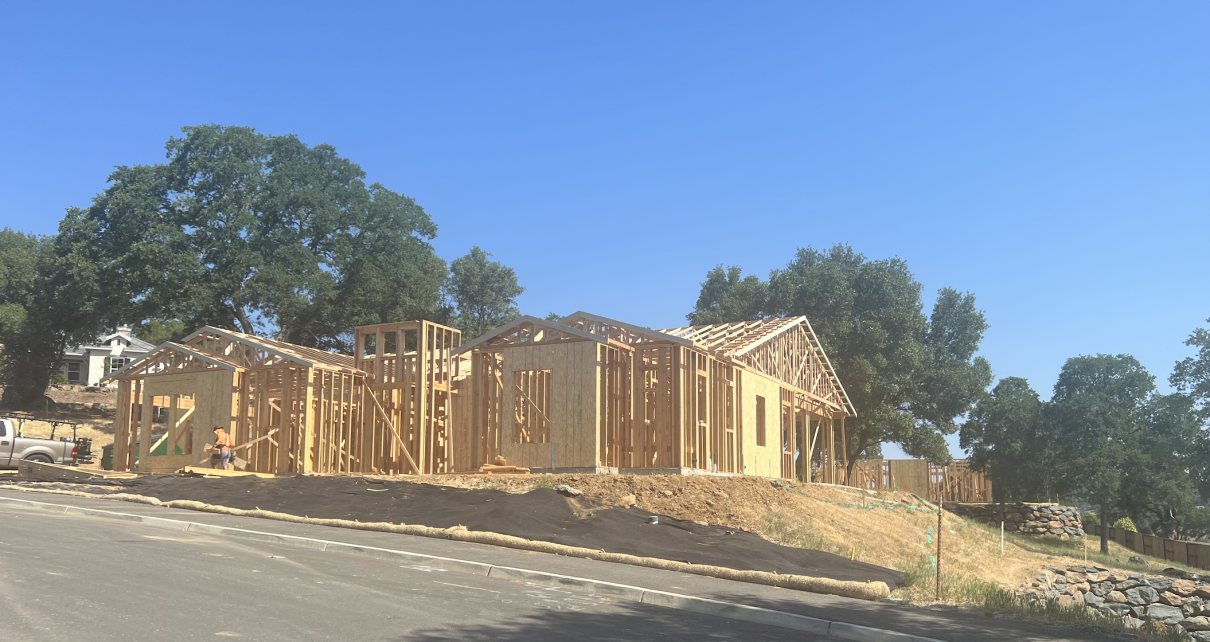
California new home development. (Photo: Katy Grimes for California Globe)
We need more housing, not more rent control
Rent control achieves the opposite of its intent
By Ethan Blevins, September 21, 2023 2:23 pm
A progressive economist once said that “rent control appears to be the most efficient technique presently known to destroy a city — except for bombing.” But California is flirting with this policy wash-up nonetheless: An initiative that would sweep aside state laws limiting rent control recently cleared the signature hurdle to hit the ballot in 2024.
California voters should reject the magical thinking behind rent control when actual solutions to our housing challenges exist.
Rent control in the United States began as a wartime measure in the early twentieth century, stuck around as urban growth exploded, then lost momentum in the 1980s as economists and the public saw its ill effects. But despite broad consensus that rent control is a false promise, it is enjoying an ominous revival.
In July, a group of economists who take a minority view on rent control sent a letter to the Biden Administration urging nationwide rent regulations, arguing that rent control helps marginalized communities and doesn’t impact housing supply. A recent Supreme Court petition challenging New York City’s rent stabilization law has also stirred up rent control’s defenders, with one housing policy analyst howling that a ruling against rent control would spell “the end of New York City.”
Perhaps rent control’s devotees hope to capitalize on growing desperation, the favored prey of most bad ideas. After all, the homelessness rate is at an all-time high, rents are at an all-time high, and the ratio of renters to owners is at an all-time high. We could use some lows, but not the kind that are comparable to carpet bombing.
Rent control achieves the opposite of its intent. A 2018 study of San Francisco’s rent control regime, for example, showed that rent control reduced the supply of rental housing, reduced housing affordability, and reduced economic equality. Those are the wrong kinds of lows.
The reason for this counterintuitive result is simple: rent control fails to account for rational human responses. Faced with an inability to receive a return on their labor and investments – or even being forced to rent property at a loss – housing providers faced with rent control often convert their property to condominiums, tenancies in common, or other uses outside the controlled market.
Rent control also discourages new construction. In 2021, St. Paul, Minnesota, capped rent increases at three percent. Three months later, permits for multi-family housing had plummeted by 82 percent in St. Paul and shot up 68 percent in neighboring Minneapolis. Rent control laws sometimes deal with this by exempting new construction, but then the rent-controlled housing pushes prices upward in the uncontrolled market.
There is a more reliable and straightforward way to lasso runaway rents: Address barriers to housing supply. Ironically, rent control is one such barrier. We need solutions that spur housing growth, not hold it back. Housing economist Jay Parsons has shown that the recent cooling of rents has not happened smoothly across the country: Rent increases are lower where housing supply is booming. That’s the right kind of low.
There are many ways to cultivate housing growth, but to name just two: Simplify permitting and open up shared living options.
Titanic permitting bureaucracies can strangle housing supply and inflate costs. Take, for instance, San Francisco’s notorious building permit labyrinth. A single residential project must slog through, on average, 87 permit approvals, 1,000 days of meetings, and more than $500,000 in fees. For example, the Balboa Reservation housing project, which would provide 1100 homes, many of them set aside for low-income residents, began its journey in 2014 and remains unbuilt today. Many projects lose funding before they get approved and die in the queue.
There are straightforward cures to this housing killer. For one, cities can move from a discretionary to as-of-right permitting process. This would mean that home builders need only meet objective criteria for approval rather than giving public officials — and often the public in general — the absolute discretion to deny a housing project or indefinitely delay it for any reason whatsoever. These smothering layers of redundant review should be streamlined or stripped away.
We can also grow supply by allowing the current housing stock to house more people through shared living. Yet local laws often get in the way of such arrangements.
For example, last year, the city of Shawnee, Kansas, adopted a “co-living” ban that prohibited four or more people from living together in a single dwelling if any adult in the group was unrelated to any other. This forced one mother to stop housing the girlfriend of one of her sons because that inserted one unrelated individual into the household. The family, represented by Pacific Legal Foundation, has sued the city for violating their property rights. The repeal of laws that restrict such shared living arrangements offers a simple way to ease the strain on supply.
Sadly, the rent control movement is enamored of a mirage that just stifles growth. Its diehard fans would do well to throw their passion and advocacy behind proven solutions that will grow housing and reduce costs. There are better and simpler ways for California to house its residents.
- We need more housing, not more rent control - September 21, 2023
- California wants to silence dissent on COVID-19 - August 1, 2022








This is a topic where many progressive and conservative thinkers come to similar conclusions, though with different motivations. Each of those 87 permit approvals, by itself, ensures that development benefits the people of The City in a way that is consistent with their (progressive) values. Yet in the aggregate, they inhibit building desperately needed housing. Ezra Klein’s podcast on the topic presents a progressive view on this.
https://podcasts.apple.com/us/podcast/why-housing-is-so-expensive-particularly-in-blue-states/id1548604447?i=1000570446982
Not hard to figure that supply and demand also applies to housing. More private lands locked up as “open space” or “prime farmland/farmland of statewide importance” by local and state agencies means less to develop housing. Add the water supply assessment law to the mix and you have a recipe for limiting the amount of land available for residential development.